
Best Hair Transplant in Pakistan
Price, Method & Complete DetailsA hair transplant is a surgical procedure that involves taking individual hair follicles and transplanting them to thinning or balding areas of the scalp. It is the preferred procedure because it promises better results, less pain/discomfort, no scarring, and is more effective. The main goal is to restore natural hair growth in areas with significant thinning or complete hair loss.
Dot Clinics is famous for its latest techniques. At our clinic, we have a highly skilled hair transplant surgeon. Our experienced surgeons are experts in FUE (follicular unit extraction) hair transplants, offering you a lifetime of permanent hair growth. Our experienced surgeons deliver precision, safety, and care at its best, making us the best for hair transplants in Pakistan.
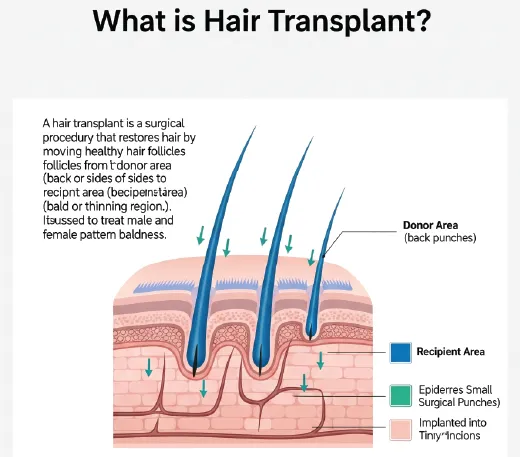
What is a Hair Transplant?
Hair transplant is an excellent surgical treatment for those who have permanent hair loss and thinning.
It is a surgical procedure in which a professional and experienced surgeon treats baldness by moving hair follicles from the donor site to the recipient area of the scalp. Generally, they extract hair from the back of the head or other parts of the body and transplant it to the front or top of the head caused by genetics.
This method can also be used to restore hair to eyelashes, eyebrows, beards, chest hair, pubic hair, and regions of the body where scarring occurred, affecting hair growth.
How Does Hair Transplant Work?
Anyone who is considering this surgery is wondering how it will work. In general, Hair transplants occur in a medical office through local anesthesia, while you remain awake and alert. The surgery process is simple, taking hair grafts from the donor area and implanting them in another area that lacks hair coverage. The process involves three simple steps:
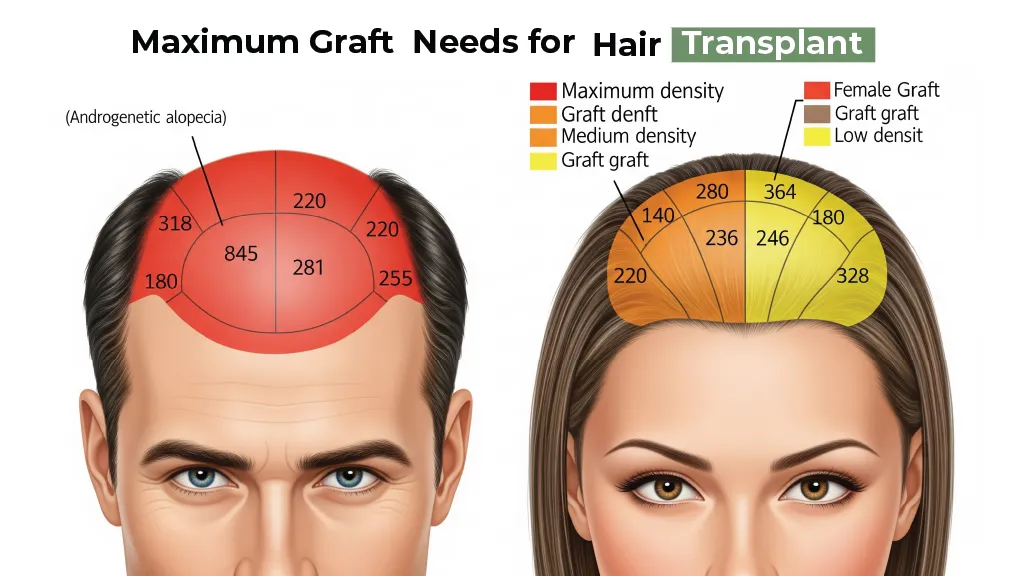
- Extraction:Individual hair follicles are carefully removed from the hair-carrying scalp.
- Preparation: Follicles are processed and prepared into minor pieces to use as grafts.
- Implantation: Follicles are carefully implanted at specific angles to replicate the natural growth direction of hair.
The transplanted hair initially falls out within 2-3 weeks (shock loss). It is completely normal. Hair roots remain live under the skin. You'll have new permanent hair growing in around 3 to 4 months, and it'll continue to grow to full length in the following 12 to 18 months.
Who is a Good Candidate for Hair Transplant?
- Individual design baldness (Androgenetic Alopecia) or Loss of Hair.
- You will be a good candidate if you have thicker hair on the donor site.
- Have realistic expectations about hair replacement results.
- Patients with good overall health.
To know you are a good candidate for a hair transplant procedure, schedule a free consultation with a skilled surgeon at Dot Clinics to discuss your medical history, restoration goals, and hair loss pattern.
Types of Hair Transplant Methods:
There are three different types of hair transplant procedures, depending on your hair loss type and goals.
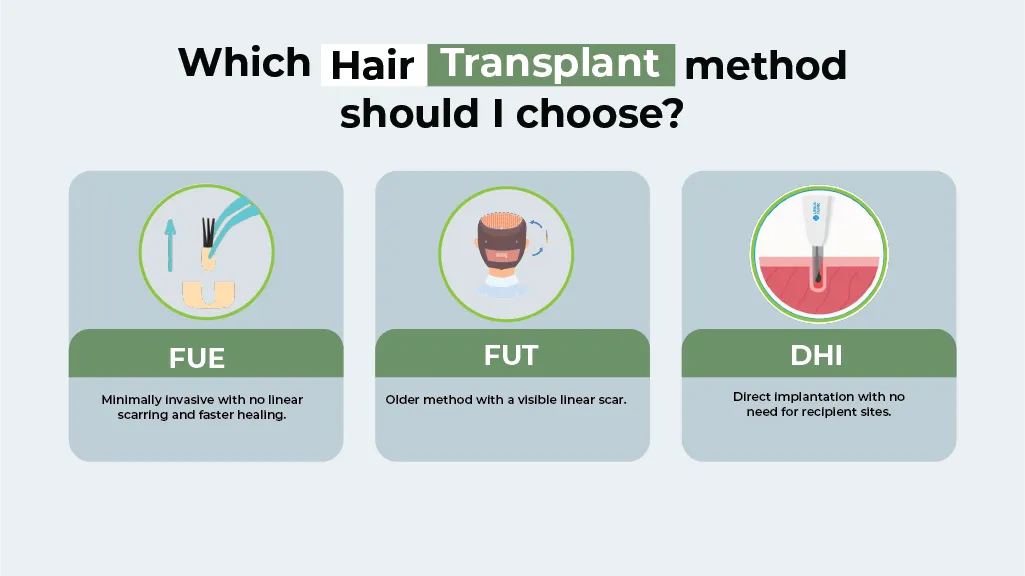
FUE (Follicular Unit Extraction):
It is the most advanced and minimally invasive hair transplantation technique in which follicular unit grafts (containing 1 to 4 hair follicles) are individually extracted using a micro-punch tool (0.6-1.0mm diameter) from the patient’s donor area and then individually transplanted to the recipient area.Advantages:
- No linear scarring
- Faster healing (7-10 days)
- Can harvest grafts from body hair if needed
- Less post-operative discomfort
- Return to work within 3-5 days
Best For Patients who prefer short hairstyles, active individuals, and those wanting minimal scarring.
Learn More About FUEDHI (Direct Hair Implantation):
DHI is an advanced variation of FUE where hair follicles are implanted directly using a specialized Choi Implanter Pen. This technique eliminates the need for creating recipient sites beforehand.
FUT(Follicular Unit Transplantation):
FUT is an older hair transplant method where all the grafts are taken as a single strip from the back of the head. From this strip, individual hair follicles are extracted and then transplanted into the recipient areas where hair is needed. Depending on the size and shape of the donor area, as well as the number of grafts required, FUT may be the preferred method for hair graft extraction.
Learn More About FUT
At Dot Clinics, we primarily recommend FUE and its variants (DHI, Sapphire) due to superior patient satisfaction and aesthetic outcomes. FUT is rarely performed due to the visible linear scar it leaves.
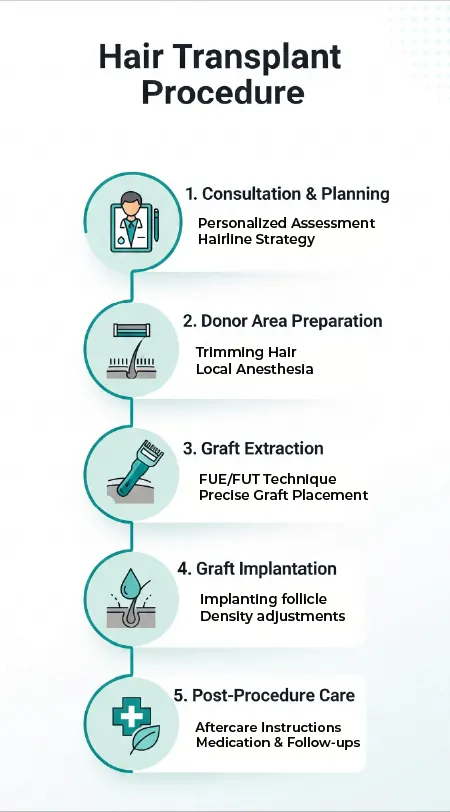
Hair Transplant Procedure at Dot Clinics
Initial Consultation:
We'll talk about what hairline shape works best for you and check out your medical background. Then, our specialist dermatologist will come up with a treatment plan just for you, walk you through everything, and show you some before-and-after pics.Pre-Procedure Preparation:
On the surgery day, your scalp will be trimmed, cleansed, and marked to design a customized hairline. Before and after photos will be taken, and local anesthesia (with optional sedation) will ensure a comfortable, pain-free experience.Hair Follicle Extraction (FUE) Technique:
Using advanced FUE technology, individual follicular units (1–4 hairs each) are carefully extracted in a strategic pattern to prevent visible thinning. Grafts are preserved in a special solution to ensure a high survival rate and natural results.Recipient Site Creation:
Micro-incisions are made precisely in the recipient site utilizing sapphire or steel knives so that the natural angle, direction, and depth are maintained. Each spot has been designed eclectically to attain maximum densification, natural movement, and minimal graft time exposure.Graft Transplantation:
In the final stage, briefly, grafts are briefly implanted into the shaped areas. Single-hair grafts provide a soft shape, a natural appearing hairline, while multi-hair grafts provide thickness behind it. Each graft is implanted with precision, care, and artistic balance to ensure a seamless and natural result.
The time depends on the number of grafts:
- 1,000-2,000 grafts: 4-5 hours
- 2,500-3,500 grafts: 6-7 hours
- 4,000-5,000 grafts: 8-9 hours
Large procedures may be split into two sessions for better graft survival and patient comfort. You can take breaks for meals and restrooms during the procedure.
Is Hair Transplant Painful?
- During Procedure: Pain is minimal. You'll be comfortable the whole time due to local anesthesia. Pressure you'll feel when grafts are being placed, but no ache. Most patients see movies or listen to music throughout the procedure.
- After Procedure: Slight pain for 2-3 days, which can be controlled comfortably with prescribed pain relief medicine. It feels like a moderate degree of sunburn. The donor area is typically more comfortable than the recipient area.
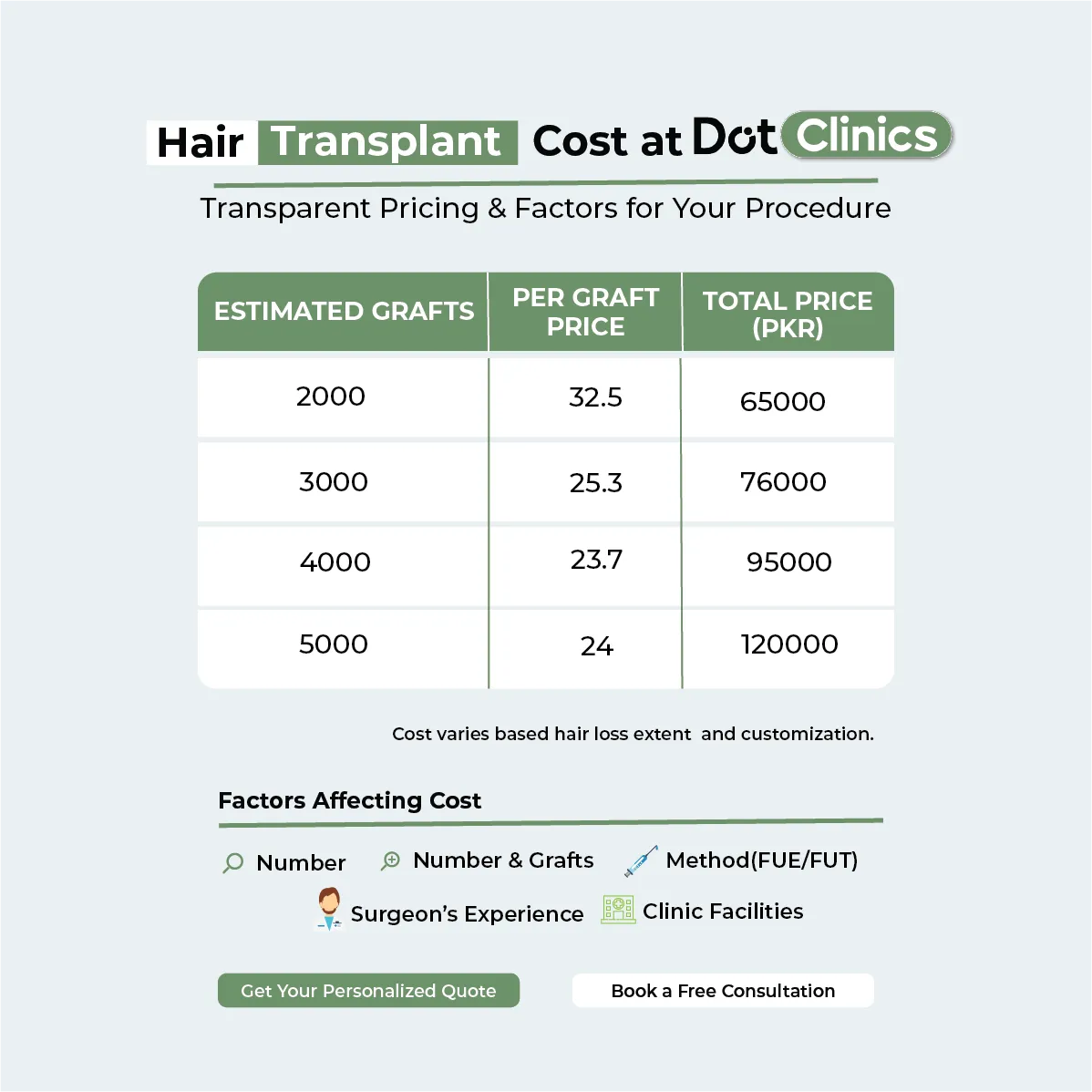
Hair Transplant Cost in pakistan
Dot Clinics offers transparent, competitive pricing for hair transplant procedures in Multan. The average cost is between 70,000 to 110,000 for 1000 to 4000 grafts at our clinic. Our costs are significantly lower than clinics in Lahore or Karachi while maintaining international quality standards. For a detailed explanation of cost, please visit Hair Transplant Cost in Pakistan.
Factors Affecting Hair Transplant Price:
- Number of Grafts: Primary cost determinant.
- Technique Used: DHI and Sapphire FUE cost more than standard FUE.
- Surgeon Experience: Senior surgeons may charge premium rates.
- Extent of Baldness: Larger areas require more grafts.
- Hair Characteristics: Curly or coarse hair provides better coverage.
- Clinic Location: Multan offers better value than major cities.
What Happens After Hair Transplant?
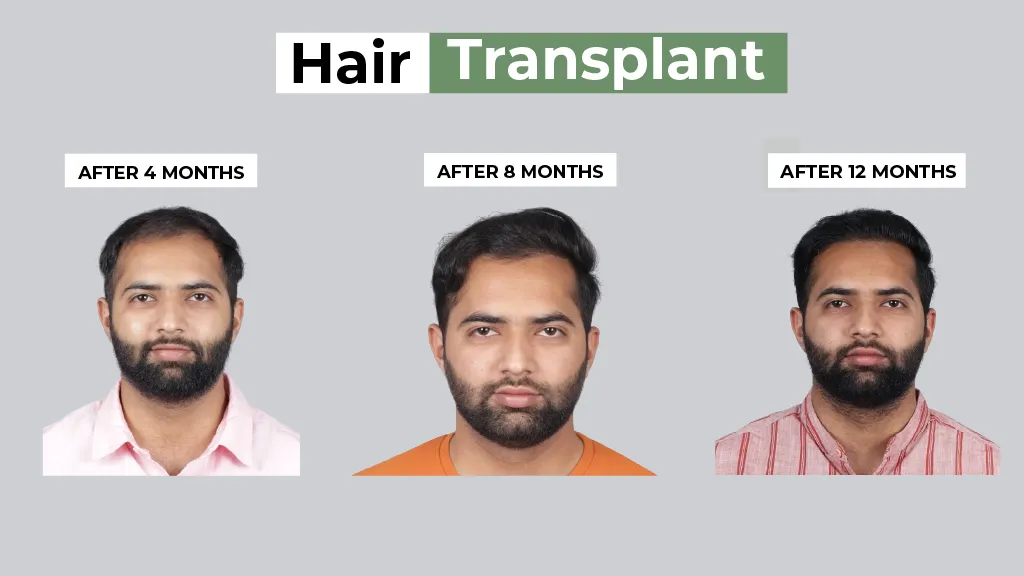
First Month: Initial Healing Phase
Within the first few weeks after getting your hair transplanted, you may experience some minimal redness as well as scabbing on the scalp. Don’t panic, however—these are only temporary signs that will diminish relatively fast as the scalp begins to heal. It’s also perfectly okay that the swapped hair will shed throughout this period, something known as shock loss. Don’t panic, the roots of your hair remain embedded, and you will have new growth to expect some 3 to 4 months after.Months 3 to 6: Early Growth Phase
By the 3-month point, you'll be able to see emerging hair growth coming in, although this first growth will be fine and thinner. As you reach the 4- to 6-month period, this growth will become thicker and more balanced. By this point, you'll have between 40 to 50% of your outcome, enough by this point to be able to attempt some minimal styling.12-18 Months: Final Results
After you pass the 7th month, the hair will get high volume, thicker, and with a more normal appearance. By the end of the 12th month, you will have around 70-80% of the denser hair you will have when you are done. By 18 months, the full effect will be visible, and the transplanted hair will meld together with the rest of the hair you have. With proper care, this effect will be permanent.
Before and After Photos
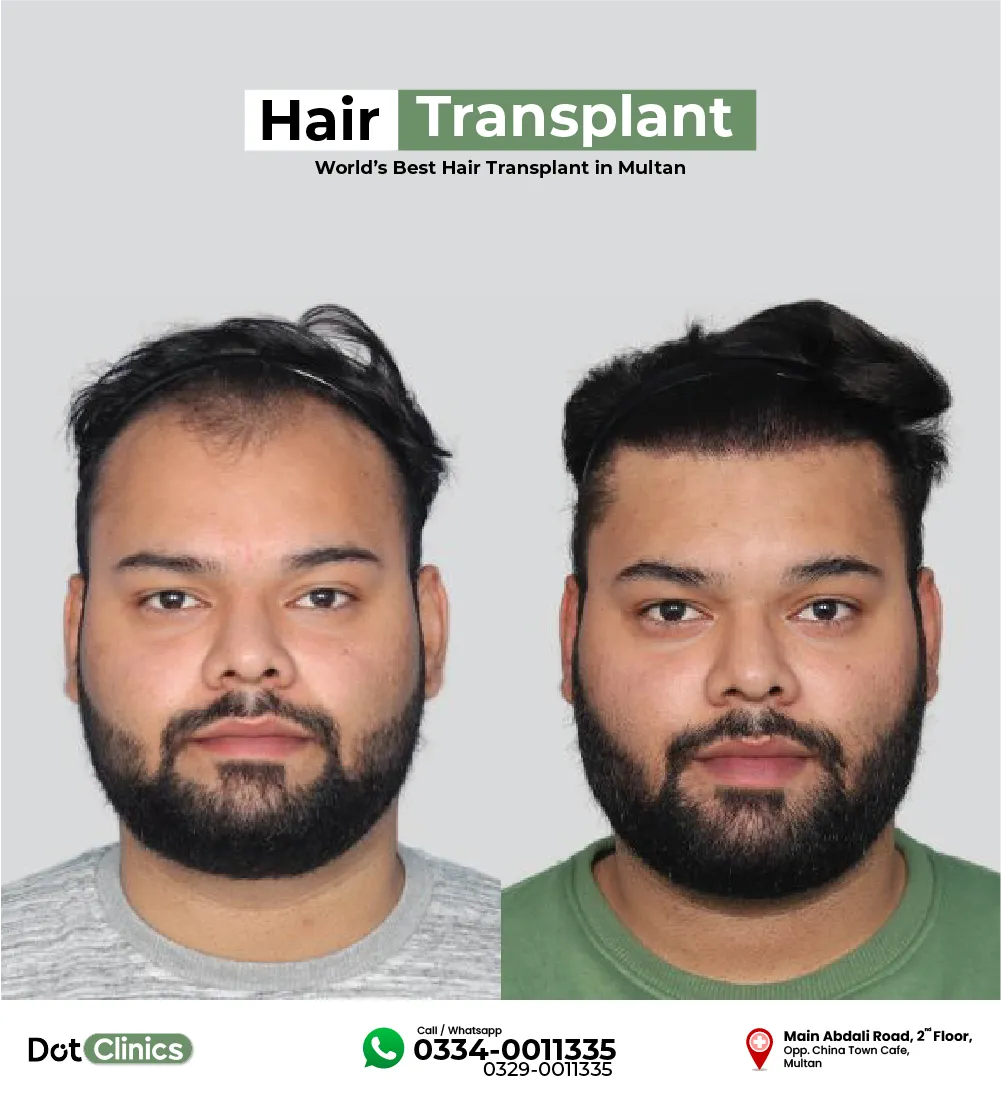
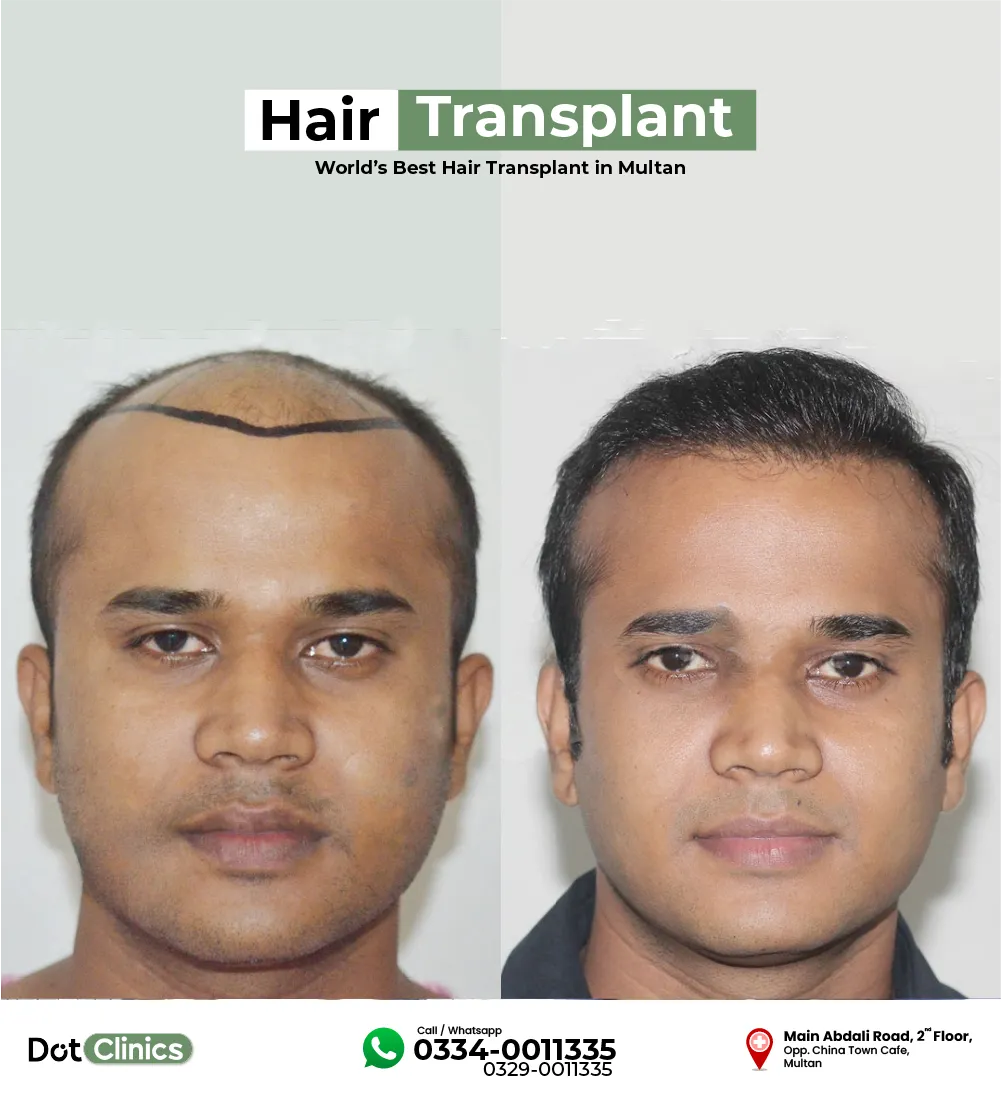
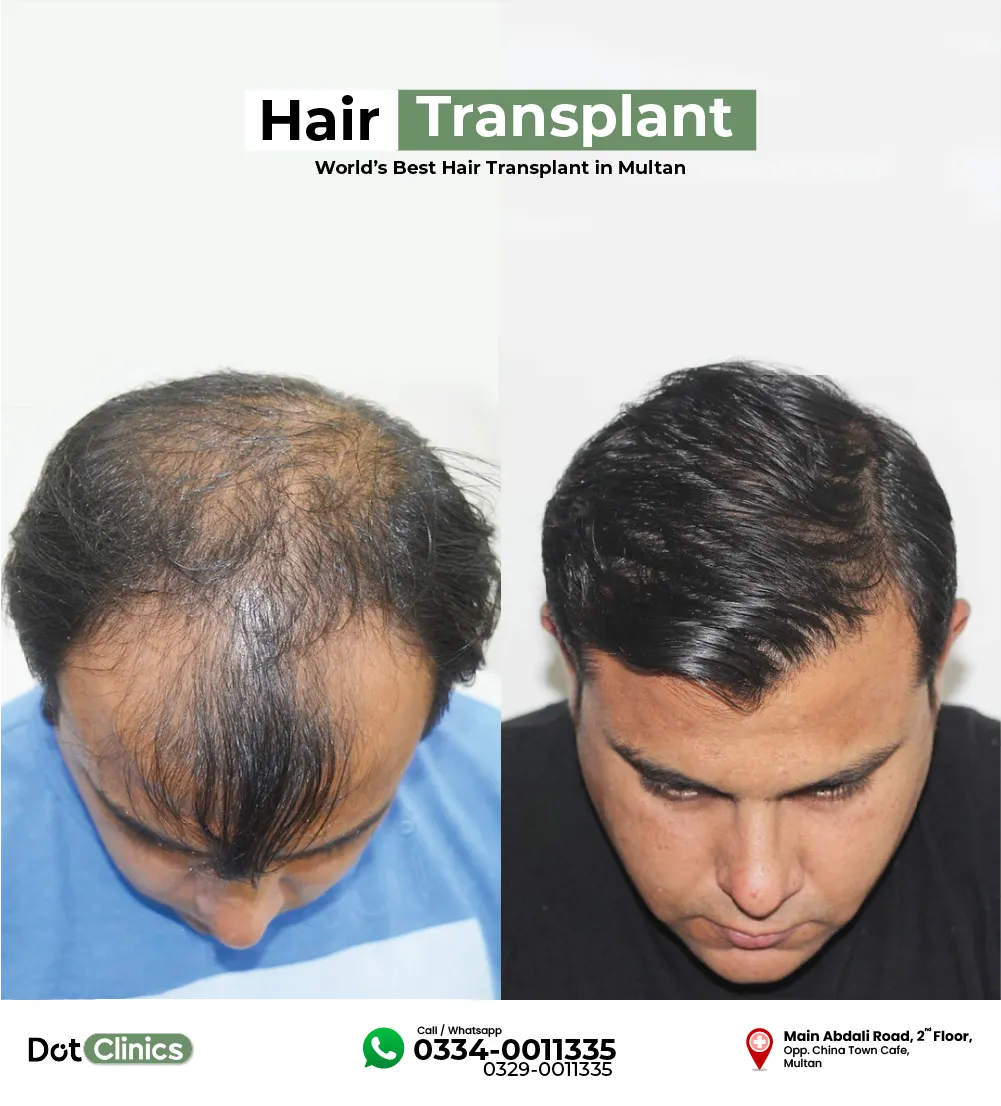
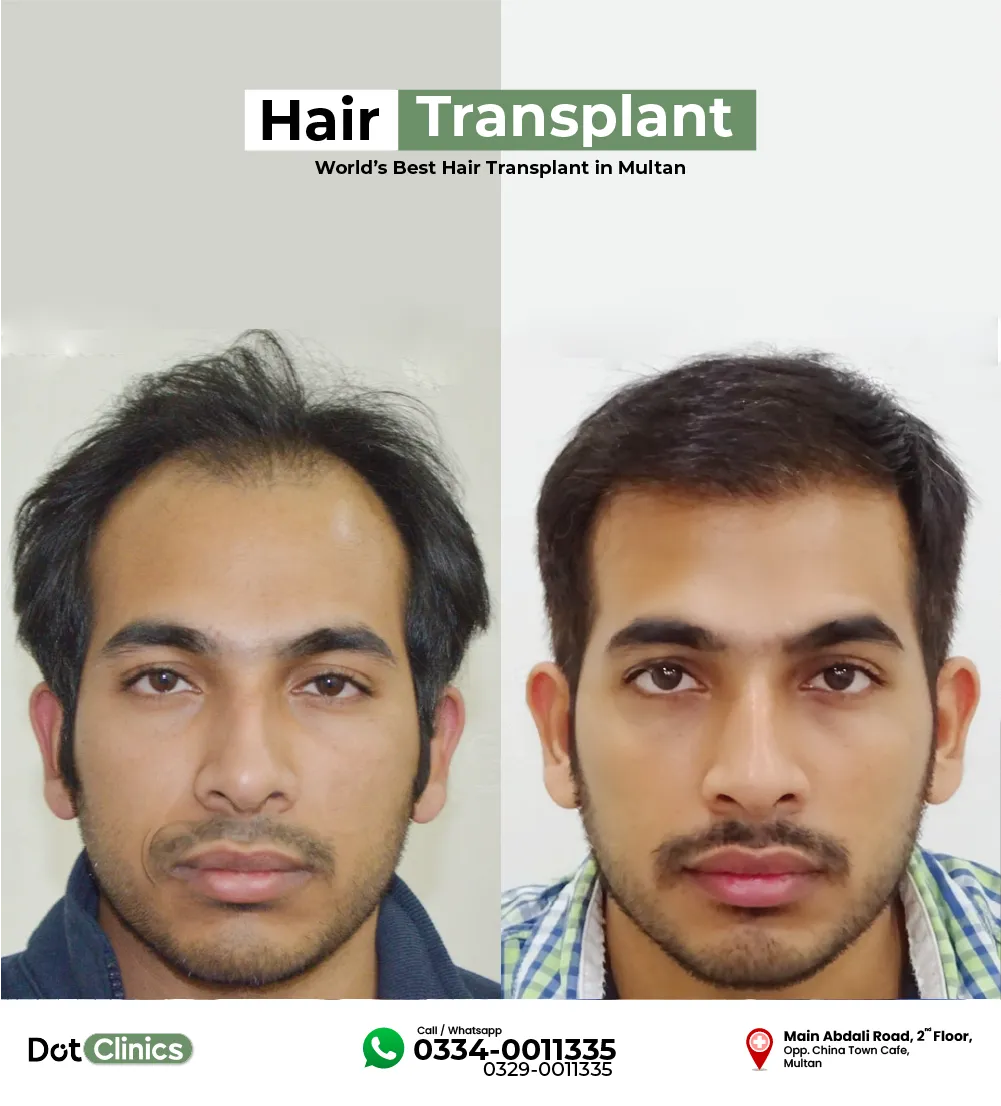
Success Rate of Hair Transplant
Success Metrics of Dot ClinicsDot Clinics has a 95% survival rate for grafts and a 98% patient satisfaction rate, always achieving natural and permanent results. Success is made possible by skills from expert surgeons, the latest technology, as well as custom-made aftercare, so each patient is under capable and trusted hands.
Potential Side Effects
Like any surgical procedure, a hair transplant may have mild side effects, which typically lasts within a few days:
- Temporary Swelling & Redness: Common in the first few days post-surgery.
- Mild Discomfort: Some patients experience tenderness at the donor and recipient sites.
- Shock Loss: Temporary shedding of transplanted hair before new growth begins.
- Scabbing & Itching: Part of the healing process but manageable with proper care.
- Minor Infection Risk: Extremely rare when post-op guidelines are followed.
Post-Procedure Care for Best Results
Our certified Specialist provides the following instructions post treatment to achieve maximum significant outcomes.
- Don't rub the scalp for a few days after the procedure to prevent rash and discomfort.
- To prevent swelling, position your head heightened during sleeping.
- Do not engage in tough physical exercise for 5-6 days post treatment.
- For at least a week, Do not expose your scalp to sunrays to prevent any infection.
- Wash your hair gently as per our specialist instructions with mild shampoos and other recommended products.
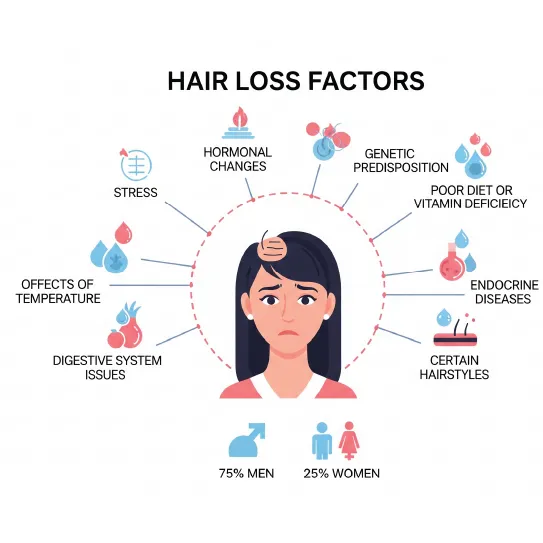
Hair Loss: Causes and Prevention
Understanding the causes of hair loss is crucial to successful treatment:
- Genetics: Hereditary Baldness patterns.
- Hormonal Imbalance: PCOS, thyroid disease, menopause, and DHT sensitivity play a role.
- Clinical Stats: It is also caused due to nutritional deficiency and alopecia areata.
- Lifestyle: Stress, nutritional neglect, tight hairstyles, and cigarette-smoking are risk factors.
- Medications: Certain medicines, like antidepressants and chemotherapy medicines, may lead to baldness.
Treatment and Prevention:
Hair transplantation is routinely performed for men, as are medical treatments such as Minoxidil. PRP treatment and hormonal evaluation are beneficial for women.
Consistent care and early cure are the requirements for good hair longevity.
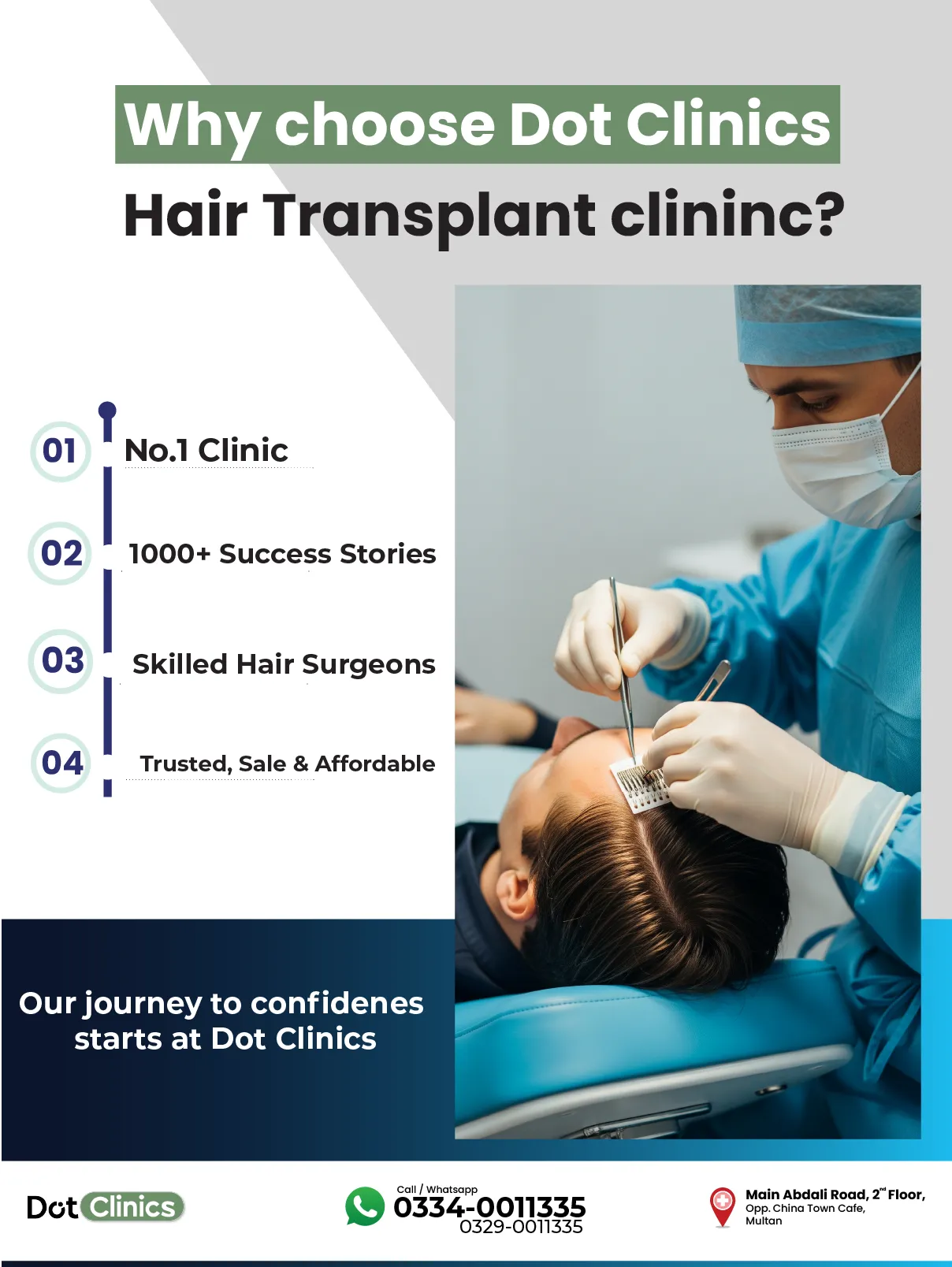
Why is Dot Clinics the Best Hair Transplant Center?
Dot Clinics is the premier transplant clinic in Multan, where medical expertise, innovative technology, and compassionate care come together to deliver natural-looking, long-lasting results. Precautions, accuracy, and constant innovations have made Dot Clinics the most dependable name among the centers of hair restoration.
Why We Are the Most Referred Hair Transplant in Multan: Skilled Surgeons: Headed by Dr. Ayesha Malik, with over 10 years of experience in hair restoration.
- Advanced Techniques: FUE, DHI, and Sapphire FUE methods for gentle results.
- Personalized Treatment: Specialized programs according to the needs of the patient.
- Natural Looking Results: Statistically designed sculpted hairline and superb graft survival.
- State-of-the-Art Equipment: Computer-assisted equipment for hair surgery.
- Safety & Hygiene: International standard sterile environment.
- Patient Comfort: Pain-free, least invasive procedures.
- Affordable Excellence: High-quality outcomes at reasonable costs.
- Extended Aftercare: Ongoing support towards a smooth recovery.
- Proven Track Record: Hundreds of pleased patients and trackable results.
Here, at Dot Clinics, we merge science and art to not just restore your hair, but your confidence as well.
HAIR TRANSPLANT FAQ's
Hair Transplant is best for those with stable hair loss and sufficient donor area.
During transplant Anesthesia is applied on the scalp to minimize any sort of pain sensation.
Single sessions normally require five to eight hours but complete time duration depends on the number of grafts.
Noticeable hair growth starts after three to four months, with full results within a year.
No, it did not ensure a complete resistance to future hair loss.
It involves mild and rare swelling, rash and tenderness with no long term side effects.
Yes you can dye and style new hair as you wish.
Complete cost depends on the number of grafts and the technique used. Average cost range is 70,000 to 110,000.
Hair transplantation is a permanent solution for balding. It is the process where existing hair-bearing follicles are grafted from the donor sites on the sides and the back of the head, where the follicles are resistant to the balding hormone, dihydrotestosterone (DHT). Grafted follicles to balding sites will grow their hair forever, retaining their resistance. Although the existing, naturally growing hair may become thin eventually, grafted hair is permanent.
There are two possible ways that the hair transplant may fail: poor growth rate/low-yielding growth, or unrealistic appearance. Low-yielding growth is encountered when the grafts are injured, so the survival level drops below the desired 85–95%. Unrealistic appearance is encountered by an incorrect design of the hairline or an incorrect angle and direction of the transplanted grafted hair. Low yield is best treated by waiting 12–18 months before re-assessment and plotting the revision procedure. Unnatural looks are treated by reversal of poorly placed grafts, micro-grafting, or additional grafting to augment the appearance. True failures are best managed by judicious evaluation and tactical revision strategy.
